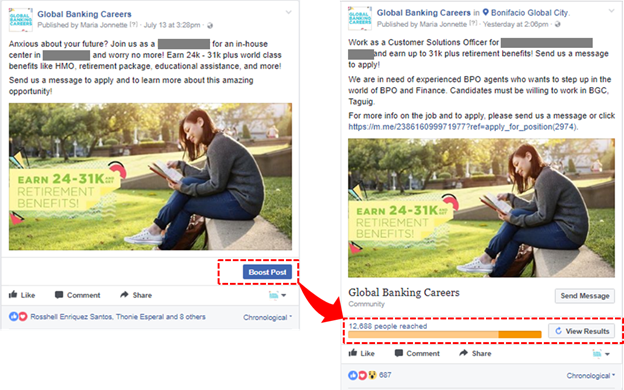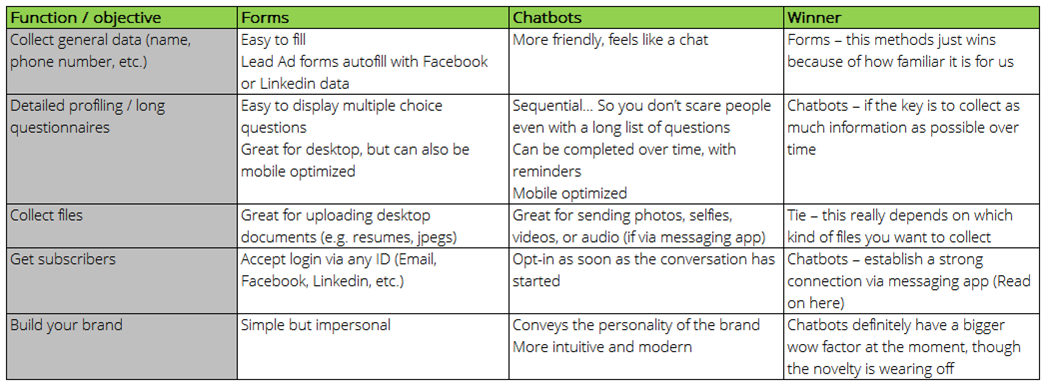Lessons learned from running social media lead generation campaigns for some of the world’s biggest employers!
If you manage a Facebook Page, you have probably already seen (or even used) a Boost Post. Any post that you publish on your Facebook wall (e.g. status updates, photos, videos or special offers) show a blue “Boost Post” button at its bottom right. If you “boost” the post, it can then appear in the “newsfeed” of your target audience. This advertising feature is offered on the native Facebook page to allow Page Admins to reach a wider audience with just a few clicks, and without going through the Facebook Ad Manager platform. It offers some level of targeting (not the advanced capabilities) and allows users to set the budgets.

It’s important to note that Boost Posts are designed to get you more “Page Engagement”, i.e. more page likes, more comments, more post likes & more reactions. Even if you include a link to your online application form, or a link to a messenger bot (which can capture more details for the lead), this is quite different than capturing hard leads. If the traffic is generated to a website, you may never be able to tell how many of those converted into actual leads.
If your goal is to get more leads for the best price — whether in a recruitment or a sales context — Facebook Lead Ads are the ideal solution. Using a Facebook Lead Ad (instead of a Boost Post) will allow you to capture candidate data right from the candidate’s Facebook profiles, reducing the application/sign up time from minutes to seconds. This data includes phone numbers, email IDs, or any other simple multiple choice or short-text question you want to ask upfront.

This ease of use directly impacts the cost effectiveness of the lead generation efforts, as we’ve seen time and time again!
Below is an example from a recent campaign we ran — where you can see that the Cost Per Lead (CPL) was reduced from $1.50 (via boost post) to $0.55 (via lead ad), a 73% reduction in cost.


Note that in the example above, the lead ad campaign also achieved similar Page Engagement results, so you are not sacrificing brand building for lead generation.
Lead vs Qualified Lead:
In recruitment, a lead might be someone who has signed up to receive a company update via email, whereas a qualified lead would be a candidate who has applied for a specific position in your company and has completed an application form and already demonstrated an ability to handle the task. By that definition, a qualified lead would likely be worth 10 times more than an unqualified lead.
Calculating the effectiveness of an advertising campaign solely on the basis of the number of leads can therefore be very misleading. We have devised the fastest ways to determine is a lead is qualified by building the first chatbot that interviews candidates over messaging apps. The chatbot can collect answers in audio and video form, so it allows for any candidate with a messaging app on their phone (e.g. Facebook Messenger, WeChat) to become a “qualified lead” within 2 to 3 minutes.
When to use Forms vs chatbots?
Practically speaking a chatbot is a machine that collects information, which is very much the function of the traditional online form (such as a Google form or a Jotform). Forms, just like chatbots, can collect rich and contextual data. Forms, just like chatbots, can be adaptive. Both can really be used to collect just about any content, via any platform. Deciding which data collection method is right for you is a complex and contextual decision.

Starting a conversation is better than just grabbing a lead.
For most of our clients, we recommend a combination of both methods: use the ease of use of the form to collect as many leads as possible + invite everyone to engage with the chatbot in order to build a stronger connection with the qualified leads. Younger generations are less likely to read emails or to answer phone calls, so you will be glad to have them engaged in a conversation with your bot on a popular messaging app like Facebook Messenger where they are sure to get your message and where they can answer it at their own pace.


